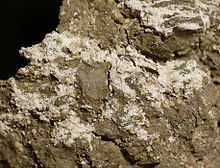
Summary
Brushite is a phosphate mineral with the chemical formula CaHPO4·2H2O. Crystals of the pure compound belong to the monoclinic space group C2/c and are colorless.[2][5] It is the phosphate analogue of the arsenate pharmacolite.
| Brushite | |
|---|---|
 Brushite (white) on montmorillonite | |
| General | |
| Category | Phosphate mineral |
| Formula (repeating unit) | CaHPO4 · 2 H2O |
| IMA symbol | Bsh[1] |
| Strunz classification | 8.CJ.50 |
| Crystal system | Monoclinic |
| Space group | Ia (no. 9) |
| Unit cell | a = 6.265 Å, b = 15.19 Å, c = 5.814 Å; β = 116.47°; Z = 4 |
| Identification | |
| Color | Colorless to pale or ivory-yellow |
| Crystal habit | Prismatic to tabular acicular crystals; typically powdery or earthy |
| Cleavage | Perfect on {010} and {001} |
| Tenacity | Brittle |
| Mohs scale hardness | 2.5 |
| Luster | Vitreous, pearly on cleavages |
| Diaphaneity | Transparent to translucent |
| Specific gravity | 2.328 |
| Optical properties | Biaxial (+) |
| Refractive index | nα = 1.539 – 1.540 nβ = 1.544 – 1.546 nγ = 1.551 – 1.552 |
| Birefringence | δ = 0.012 |
| 2V angle | Measured: 59 to 87° |
| Solubility | Readily in HCl |
| Other characteristics | Piezoelectric |
| References | [2][3][4][5][6] |
Discovery and occurrence edit
Brushite was first described in 1865 for an occurrence on Aves Island, Nueva Esparta, Venezuela, and named for the American mineralogist George Jarvis Brush (1831–1912).[4] It is believed to be a precursor of apatite and is found in guano-rich caves, formed by the interaction of guano with calcite and clay at a low pH. It occurs in phosphorite deposits and forms encrustations on old bones. It may result from runoff of fields which have received heavy fertilizer applications.[4] Associated minerals include tanarakite, ardealite, hydroxylapatite, variscite and gypsum.[2]
Brushite is the original precipitating material in calcium phosphate kidney stones.[7] It is also one of the minerals present in dental calculi.
References edit
- ^ Warr, L.N. (2021). "IMA–CNMNC approved mineral symbols". Mineralogical Magazine. 85 (3): 291–320. Bibcode:2021MinM...85..291W. doi:10.1180/mgm.2021.43. S2CID 235729616.
- ^ a b c Anthony, John W.; Bideaux, Richard A.; Bladh, Kenneth W.; Nichols, Monte C., eds. (2000). "Brushite". Handbook of Mineralogy (PDF). Vol. IV (Arsenates, Phosphates, Vanadates). Chantilly, VA, US: Mineralogical Society of America. ISBN 0962209732. Archived from the original (PDF) on 2016-03-04.
- ^ Brushite. Mineralienatlas]
- ^ a b c Brushite. Mindat.org
- ^ a b Brishite. Webmineral
- ^ Schofield, P. F.; Knight, K. S.; Houwen, J. A. M. van der; Valsami-Jones, E. (December 2004). "The role of hydrogen bonding in the thermal expansion and dehydration of brushite, di-calcium phosphate dihydrate". Physics and Chemistry of Minerals. 31 (9): 606–624. Bibcode:2004PCM....31..606S. doi:10.1007/s00269-004-0419-6. S2CID 94011250.
- ^ "Brushite". Virtual Museum of Molecules and Minerals. Retrieved 22 December 2017.


